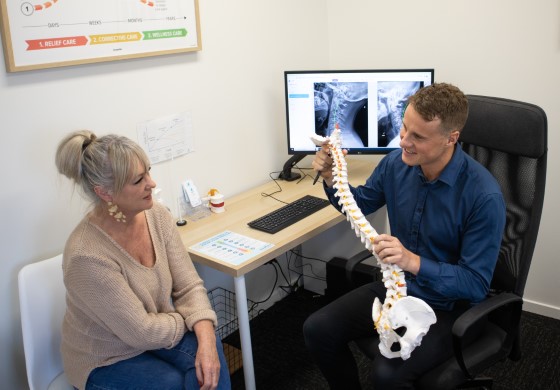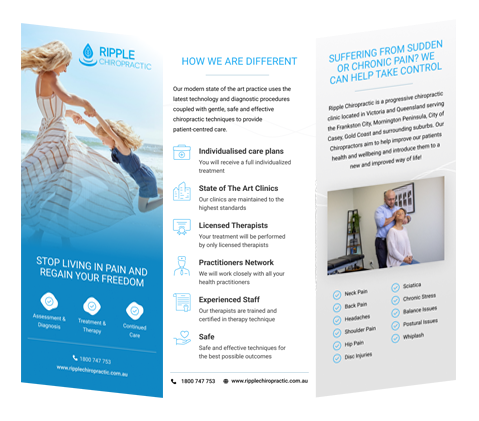Chiropractor For Scoliosis - Melbourne
- Comprehensive History
- Health Goal Setting
- Orthopedic Exam
- Neurological Exam
- Biostructural Exam
- 3D Posture Analysis
- Range Of Motion Exam
- Referral For Diagnostic Imaging
- First Follow Up Treatment
EXCELLENTBased on 109 reviews Trustindex verifies that the original source of the review is Google.
Trustindex verifies that the original source of the review is Google. Helena Annelise2022-05-26All the chiropractors have been so helpful and their reception is friendly and personable! As someone who works 8 hours a day at a desk I am grateful to have them. Truly recommend Ripple if you are in search for a chiro to help your road to recovery. Thanks again!Trustindex verifies that the original source of the review is Google.
Helena Annelise2022-05-26All the chiropractors have been so helpful and their reception is friendly and personable! As someone who works 8 hours a day at a desk I am grateful to have them. Truly recommend Ripple if you are in search for a chiro to help your road to recovery. Thanks again!Trustindex verifies that the original source of the review is Google. Trevor Wyhoon2022-04-29Im normally not one to recommend, but this team is Fantastic!!!. They help you set goals for your care and lead you through them. Great results, cannot recommend them highly enough.Trustindex verifies that the original source of the review is Google.
Trevor Wyhoon2022-04-29Im normally not one to recommend, but this team is Fantastic!!!. They help you set goals for your care and lead you through them. Great results, cannot recommend them highly enough.Trustindex verifies that the original source of the review is Google. Laura Feddersen2022-03-25Ripple chiropractic is like no other I have experienced. The care is 10/10, the investigative work done to understand my issues was thorough. They educated me to understand how I got to this point and how we were going to correct it. I couldn't be happier at Ripple.Trustindex verifies that the original source of the review is Google.
Laura Feddersen2022-03-25Ripple chiropractic is like no other I have experienced. The care is 10/10, the investigative work done to understand my issues was thorough. They educated me to understand how I got to this point and how we were going to correct it. I couldn't be happier at Ripple.Trustindex verifies that the original source of the review is Google. Melissa Parkinson2022-02-16Highly recommend!! My family has been seeing Dr Aleks and the team at Ripple Chiropractic for many months now and we cannot be happier with the level of care and treatment we have received. We have all had amazing results and cannot thank Dr Aleks enough.
Melissa Parkinson2022-02-16Highly recommend!! My family has been seeing Dr Aleks and the team at Ripple Chiropractic for many months now and we cannot be happier with the level of care and treatment we have received. We have all had amazing results and cannot thank Dr Aleks enough.
Scoliosis is a condition characterised by an abnormal lateral curvature of the spine, which can lead to significant discomfort and health complications. Traditional scoliosis treatment often involves invasive methods such as bracing or spinal fusion surgery.
However, chiropractic care offers a non-invasive, holistic alternative for treating scoliosis that can provide relief and improve quality of life for many patients. Read on to discover the role of a chiropractor for scoliosis in managing the condition and the specific techniques used to treat it.
Understanding Scoliosis
Scoliosis can be classified into several types, each with distinct causes and characteristics:
- Idiopathic Scoliosis: This is the most common type, with no identifiable cause. It often manifests during adolescence, known as adolescent idiopathic scoliosis.
- Congenital Scoliosis: Resulting from spinal abnormalities present at birth.
- Neuromuscular Scoliosis: Associated with neuromuscular conditions such as cerebral palsy or muscular dystrophy.
- Functional Scoliosis: A temporary curvature caused by conditions such as leg length discrepancy or muscle spasms.
Scoliosis Symptoms and Diagnosis
Scoliosis symptoms can vary depending on the severity of the curvature. Common signs include uneven shoulders, an asymmetrical waist and one hip higher than the other. In severe cases, scoliosis pain can become a significant issue, affecting daily activities.
Diagnosis typically involves a physical examination and imaging tests, such as X-rays, to assess the extent of the spinal deformity. Early diagnosis is crucial for effective treatment, especially in cases of very mild scoliosis, where conservative treatment options can be most effective.
The Role of Chiropractic Care in Scoliosis Management
Chiropractic care focuses on the diagnosis and treatment of musculoskeletal disorders, particularly those affecting the spine. For scoliosis patients, chiropractic care can offer several benefits by improving spinal alignment, reducing pain and enhancing overall function.
How Chiropractic Adjustments Help
Chiropractic adjustments, also known as spinal manipulations, are a core component of chiropractic treatment for scoliosis. These adjustments aim to:
- Improve spinal alignment by correcting misalignments in the spinal column.
- Enhance mobility and flexibility of the spinal discs and joints.
- Alleviate pain associated with scoliosis by reducing pressure on nerves and muscles.
The Holistic Approach
Chiropractic care adopts a holistic approach, addressing the entire musculoskeletal system rather than just the spine curves. This approach includes:
- Exercise Therapy: Special exercises to strengthen the muscles supporting the spine, improving posture and stability.
- Soft Tissue Therapy: Techniques such as massage and myofascial release to relieve muscle tension and improve blood flow.
- Lifestyle and Ergonomic Advice: Guidance on posture, ergonomics and daily activities to support spinal health and prevent further curvature progression.
Stop Living in Pain and Regain Your Freedom

Chiropractic Techniques for Scoliosis
Chiropractors employ various techniques to treat scoliosis, tailored to the individual needs of each patient. Some of the most effective chiropractic techniques for scoliosis include:
Spinal Adjustments
Spinal adjustments involve applying controlled force to specific joints in the spine. These adjustments help to:
- Realign the spinal column
- Improve joint function
- Reduce scoliosis pain
Exercise Therapy
Exercise therapy plays a vital role in chiropractic rehabilitation for scoliosis patients. Customised exercise programmes aim to:
- Strengthen the core and back muscles
- Enhance flexibility and mobility
- Support spinal alignment and reduce curvature progression
Soft Tissue Therapy
Soft tissue therapy techniques, such as massage and myofascial release, are used to:
- Relieve muscle tension
- Improve circulation
- Support the effectiveness of chiropractic adjustments
Benefits of Chiropractic Care for Scoliosis
Chiropractic care offers several benefits for scoliosis patients, making it an attractive option for those seeking non-invasive treatment methods. Key benefits include:
Pain Relief
Chiropractic adjustments and soft tissue therapy can significantly reduce scoliosis pain by addressing the root causes of discomfort and improving overall spinal function.
Improved Spinal Alignment
Regular chiropractic treatment can help to correct misalignments in the spinal column, leading to better posture and reduced curvature progression.
Enhanced Mobility and Flexibility
By improving joint function and relieving muscle tension, chiropractic care can enhance the mobility and flexibility of scoliosis patients, enabling them to lead more active and comfortable lives.
Prevention of Further Curvature Progression
Early intervention with chiropractic care can prevent the progression of spine curves, particularly in cases of mild scoliosis and adolescent idiopathic scoliosis.
Why choose us as your chiropractor for
scoliosis in Melbourne?
Choose Ripple Chiropractic as your chiropractor for scoliosis in Melbourne for our expert, patient-centred care. We offer personalised, non-invasive treatments to improve your spinal health and enhance your quality of life.
Individualised care plans
You will receive a full individualised treatment
State of The Art Clinics
Our clinics are maintained to the highest standards.
Licensed Therapists
Your treatment will be performed by only licensed therapists
Practitioners Network
We will work closely with all your health practitioners
Experienced Staff
Our therapists are trained and certified in therapy technique
Safe
Safe and effective techniques for the best possible outcomes.
How to schedule an appointment to see a chiropractor for scoliosis
If you want to schedule an appointment to see a chiropractor for scoliosis, you can give us a call on (03) 9864 1819 or you can fill out our online booking form.
FAQs
If you have any more questions about chiropractic scoliosis treatment in Melbourne, please don’t hesitate to contact us today. In the meantime, check out our most frequently asked questions below which may provide the additional information you’re looking for.
Can a chiropractor fix scoliosis?
A scoliosis chiropractor can significantly help in managing and alleviating the symptoms of scoliosis. While chiropractic adjustments cannot completely cure scoliosis, they can improve spinal alignment, reduce pain and enhance mobility, providing considerable relief and a better quality of life for scoliosis patients.
Is chiropractic care effective for adult scoliosis patients?
Yes, chiropractic care can be very effective for adult scoliosis patients. Through targeted chiropractic adjustments and personalised treatment plans, chiropractors can help alleviate pain, improve spinal function and enhance overall well-being, making it a viable option for adults seeking non-invasive scoliosis treatment.
What role does a chiropractic adjustment play in scoliosis treatment?
Chiropractic adjustment plays a crucial role in scoliosis treatment by realigning the spinal column, improving joint function and reducing discomfort. These adjustments, performed by a scoliosis chiropractor, help to address the underlying issues causing scoliosis symptoms, leading to better spinal health and reduced pain.
How is scoliosis diagnosis important for effective chiropractic care?
Accurate scoliosis diagnosis is essential for developing an effective chiropractic care plan. Understanding the type and severity of scoliosis allows the chiropractor to tailor adjustments and other treatments to the patient’s specific needs, ensuring the best possible outcomes in managing and alleviating scoliosis symptoms.
General Information Disclaimer: The content provided here is for informational purposes only and is not intended as medical advice, diagnosis, or treatment. Always seek the advice of your health professional with any questions you may have regarding a medical condition. The information on this site is general in nature and may not reflect current medical developments or research. Your reliance on any information provided by this site is solely at your own risk.
Grab Our New Patient Offer Today
Consultation + 1st Treatment

We are offering a special price for your consultation + 1st treatment which will include all of the following:
- Comprehensive history including chief complaint, trauma and medical history.
- Health goal setting
- Orthopedic exam
- Neurological Exam
- Biostructural Exam
- 3D posture analysis
- Range of motion exam
- Referral for diagnostic imaging if clinically appropriate
- First follow up treatment



